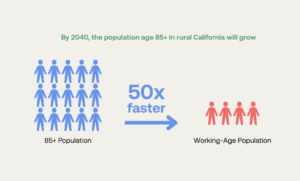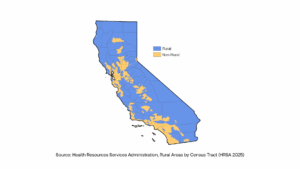Rural Aging Policy Brief Series
Rural older adults face distinct realities that California’s statewide planning must address. To support equitable solutions, we are pleased to share three new policy briefs.
These briefs provide legislators and advocates with clear, actionable recommendations to address the needs of rural older adults, a population that is growing rapidly and already straining under workforce shortages, housing insecurity, and health disparities.
Investing in rural aging not only strengthens local communities, it also prevents costly hospitalizations and nursing home placements that strain the state budget, helping ensure the Master Plan for Aging delivers on its promise for all Californians, including the most rural.
- Closing the Care Gap Strengthening Long Term Services and Supports in Rural California
This brief identifies barriers facing older adults, family caregivers, and the direct care workforce and recommends strategies to support rural family caregivers, address barriers to aging in place, and build more resilient LTSS systems. - Rural Health Care Policy Solutions for California’s Older Adults
This brief examines disparities driven by healthcare closures, workforce shortages, and fragmented systems and recommends policies to strengthen the rural health workforce, simplify navigation, improve care coordination, and expand digital health, transportation, and community-based education. - Addressing Older Adult Homelessness and Housing Instability in Rural California
This brief explores “hidden” homelessness in rural areas, barriers to accessing services, declining infrastructure, and rising costs and offers solutions for preserving housing stability and expanding rental and legal protections.
Together, these briefs provide a roadmap to ensure rural Californians can age with dignity and purpose. An additional resource, Why Action Is Needed Now, introduces rural realities that impact equity, resources, and the future of aging in the state.
Why Focus on Rural Aging
Rural aging voices and experiences have continually been left out of policy discussions, despite representing a significant and growing population. Currently, one in eleven Californians ages 65+ (8.6%) live in a rural or frontier area, spanning 57 of California’s 58 counties.1 By 2040, the population ages 85+ in rural California will grow 158%, nearly 50 times faster than the traditional working-age population (ages 18-64).2

In our work to support the development of local Master Plans for Aging in rural areas, we heard from stakeholders that programs and policies that the work in urban and suburban areas often doesn’t translate to rural communities. Community members elevated challenges in access to long-term services and supports (LTSS), health care, and housing, as well as recommendations to address these challenges. These learnings and recommendations are distilled into three policy briefs to educate and inspire policymakers and advocates to take action. With federal policy actions reducing funds for Medicaid and other programs and the state facing ongoing fiscal pressures, it is more urgent than ever to ensure the needs of older adults, people with disabilities, and family caregivers living in rural areas are prioritized.
A background document, Who Counts as Rural? Why It Matters for California’s Older Adults, provides important context for the briefs, highlighting an overview of California’s rural aging population and the ways differing definitions of ‘rural’ shape funding and planning for programs.
Rural Areas Cover 57 of 58 California Counties
Three Policy Briefs: A Roadmap for Action
These policy briefs provide practical solutions and opportunities for state policy and investments to support aging well for rural Californians. Developed with learnings from older adults, caregivers, and providers from Regional Coalitions in Northern California, the Central Valley, and the Inland Empire, they highlight pressing needs and actionable recommendations for improving access to LTSS, health care, and housing in rural areas.
How Policymakers and Stakeholders Can Use These Briefs
These briefs are designed for California policymakers and stakeholders to:
- Understand the unique experiences of rural older adults and people with disabilities and their caregivers
- Inform equitable policy design and budget decisions
- Support education, testimony, and constituent education
- Embed a rural lens in state planning initiatives
Additional Resources
Other resources developed as part of our rural master plan for aging initiative that may be helpful include:
- A Toolkit for Developing Local Multisector Plans for Aging in Rural Areas (toolkit and webinar recording)
- Developing a Local MPA to Address the Needs of Older & Disabled Adults in Rural Communities (webinar recording)
References
- Authors’ analysis of 2023 American Community Survey (ACS) 5-year estimates. Share of Californians aged 65+ residing in rural census tracts calculated using the Health Resources Services Administration (HRSA) Rural Areas by Census Tract (based on OMB county classifications, RUCA codes, and Road Ruggedness Scale adjustments). Updated September 2025. https://www.hrsa.gov/rural-health/about-us/what-is-rural
- Authors’ analysis of California Department of Finance, Demographic Research Unit, Population Projections (2025 Series). County-level projections for age groups aggregated to rural vs. non-rural counties using the 2023 NCHS county classification. Results are population-weighted.

